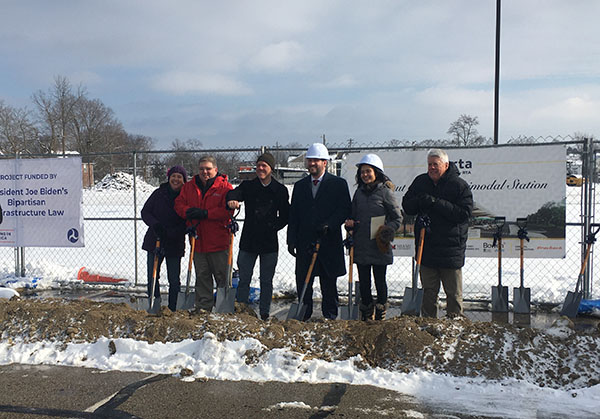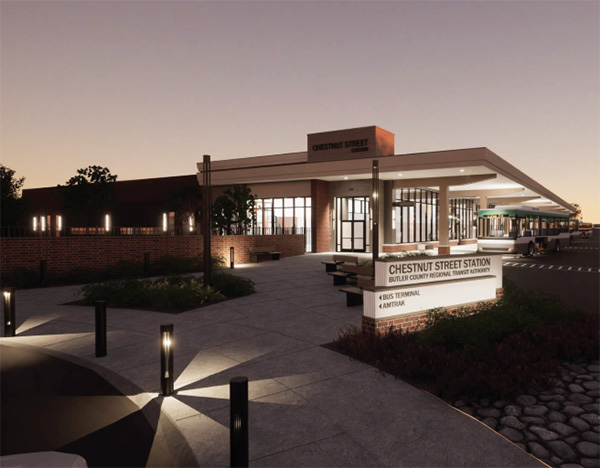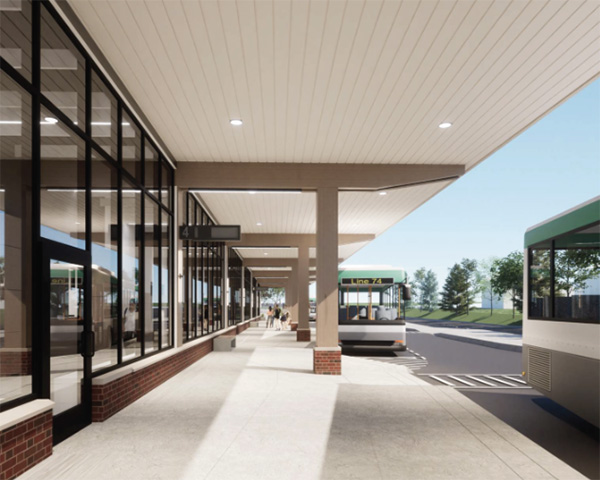BCRTA breaks ground on Chestnut Street Multimodal Station Jan. 19 with Miami and city of Oxford
The transportation hub is expected to be in operation by September 2025

BCRTA breaks ground on Chestnut Street Multimodal Station Jan. 19 with Miami and city of Oxford
Groundbreaking for Chestnut Street Station, a multimodal transportation center located at 97 W. Chestnut Street — part of the former site of Talawanda High School — took place Jan. 19.
The $25.8 million project, led by the Butler County Regional Transit Authority (BCRTA) in collaboration with Miami University, has been in the planning stages for more than 10 years.
BCRTA executive director Matthew Dutkevicz, who “started this journey in 2015,” said he has worked with the community for a long time to get the transportation hub project right.
Funding for the project includes $1.6 million from Miami University, $2.4 million from BCRTA, and $21.7 million from the U.S. Department of Transportation Federal Transit Administration, according to Dutkevicz.
Miami also provided a 40-year lease-in-kind of several parcels for the construction and operation of the facility.
“The transit hub will fulfill transit needs throughout Butler County and positively affect countless lives, day in and day out. We’re deeply proud of the development and can’t wait for the beautiful space to take shape and transform the community we proudly serve," Dutkevicz said.

The design of the 57,000 square foot facility blends with the architectural design of Miami’s Oxford campus “with a modern flair,” said Ken Emling, director of Public Architecture for Bowen+.
Also known as the Chestnut Street Multimodal Station and Shared Services Facility, the facility is unique in that it combines a transit center for passengers with bus storage, and vehicle maintenance, fueling, and washing operations— two areas that are usually separated, Emling said.
The facility is located between Miami’s Chestnut Fields parking lot and the site of a future Amtrak station. A $2 million award from the Ohio-Kentucky-Indiana Regional Council of Governments (OKI) will help fund the Amtrak platform project. Led by the city of Oxford, the project is expected to begin construction in 2026. The Oxford platform will be part of Amtrak’s Cardinal Line from New York to Chicago. The line travels through Oxford now but does not stop.
Passengers can arrive by car, bus, bike, scooter, or foot to the multimodal facility. Phase 5 of the Oxford Area Trails, connecting Talawanda Middle School with Talawanda High School, will also connect the trails to Chestnut Street and the new facility. Phase 5 construction will begin in 2025.

Planting the seeds
In his remarks during the groundbreaking ceremony, David Creamer, vice president for Finance and Business Services at Miami University, said “we accomplish so much more when we work together.”
Miami’s partnership with BCRTA has allowed for new buses on campus and for this facility, Creamer said. “Our dollars spent will come back in multiples,” he said, noting that the project is about 90% paid for with federal and state funds.
When he joined Miami 16 years ago, one of the first people Creamer met was Prue Dana, then mayor of the city of Oxford and a strong advocate for public transportation. She “planted the seed” for this project, he said.
Dutkevicz acknowledged the project partners and long-time supporters, including the late Ben Spilman, retired captain of Miami University Police and director of Parking and Transportation Services. Spilman was also a founding member of Miami’s Sustainability Committee.
David Prytherch, professor of Geography and Oxford City Council member, was Miami’s first sustainability coordinator (2009-2012). "When we started our sustainability efforts, Miami students were shuttled in private school buses and Oxford had no public transit," Prytherch said. "One of our first Sustainability Goals and Commitments adopted in 2010 was to create a fully public transit system (with Dr. Creamer's full support).”
“Fast forward 15 years, and now BCRTA provides fare-free service to all Oxford residents," he said. "And after years of patient planning it's exciting to break ground on a state-of-the-art facility that will make it easier to travel to, from, and around Oxford car-free."
Keep up to date on the project on the BCRTA Chestnut Street Multimodal Station website.
The facility will include:
- Indoor and outdoor passenger waiting areas.
- Accessible public restrooms.
- Bike storage.
- Real-Time transit information.
- Passenger kiosks/Customer service.
- Covered bus transfer areas.
- Community meeting space.
- Bus maintenance, fueling, washing, and indoor storage areas for around 40 buses.
- Accommodations for future battery-electric or hydrogen fueling.
- Accommodations for future solar energy capture.
- Shared access and amenities for proposed Amtrak service.